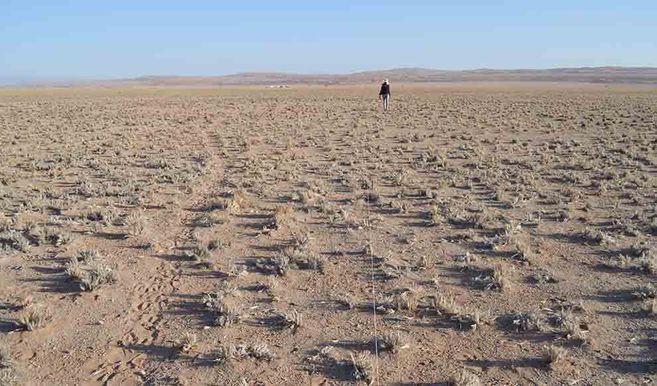- Climate crisis: This is how Spain is transforming climate change
- Environment: Spain, a critical point of climate change
Arid lands make up 45% of the planet's non-aquatic surface and provide livelihoods, through activities such as livestock or agriculture, to about 2.5 billion people. Since, in addition, they are especially sensitive to climate change, experts consider it essential to know what kind of transformations they face. A new study, conducted at the University of Alicante and published in Science , has just shed light on the problem, although its conclusion is worrisome: once certain levels of aridity have been overcome, the changes will not be proportional, but drastic.
Despite what might be assumed, the intensification of aridity will not occur "little by little", as the temperature rises, but this kind of terrain will respond to changes disproportionately, leading to a more abrupt desertification of I thought The areas most exposed to this process are those that now have a more arid climate. In the case of Spain, Alicante , Murcia and Almeria , in the southeast of the Peninsula, in addition to islands such as Lanzarote and Fuerteventura are the most threatened areas, according to the researchers.
"The fundamental properties of arid ecosystems, such as the productivity of their vegetation or the fertility of their soils, respond non-linearly to increases in aridity, such as those expected with climate change," Fernando Maestre, director of the Laboratory of Arid Zones and Global Change of the University of Alicante , from which the research has been carried out. "When the aridity increases slightly , the values of these properties change disproportionately, " he says.
Research has detected three thresholds - or critical levels - in the aridity of ecosystems. Once one of them is reached, the intensification of the aridity accelerates in an increasingly abrupt way. The first threshold (aridity with a value of 0.54, according to scientists) corresponds to aridity levels " similar to those we have in the Mediterranean, " Maestre said. As soon as it is exceeded, the lands begin to lose productivity faster. The second threshold (0.7) has "values similar to those found in the southeast of the Iberian Peninsula ". Above it, there is a significant loss of nutrients and microorganisms necessary for the development of vegetation.
The third and most dramatic threshold (0.8) is the one that, once exceeded, leads to "a drastic fall in plant cover and diversity, which eventually leads to the appearance of deserts ." That is, desertification of ecosystems is not a gradual process, but it increases dramatically when each of these three points of no return that researchers have just identified is overcome.
By contrasting the results of the new research with the predictions about climate change, scientists have observed that up to 18% of the current land area will cross, by the year 2100, at least one of the three thresholds detected. In our country, the figure is higher. According to estimates made by Miguel Berdugo, lead author of the study, at the request of this newspaper, " the percentage is around 75% of the area of Spain " when all regions are contemplated, including the much less arid - and more difficult to estimate- from the north. "If we ignore these areas, which are less clear, the percentage is 60%, " says this researcher, who currently works at the Pompeu Fabra University .
In the case of the aforementioned areas of the peninsular southeast or the Canary Islands , which are already at aridity levels close to the second threshold, the next jump would therefore be the most drastic. If the weather forecasts are met and the changes follow the pattern identified in the new study, "there will be very marked reductions in plant cover and diversity, " warns Maestre. A process that will ultimately "result in the degradation of the natural ecosystems of these areas and their desertification."
Therefore, the researchers believe that their study will be important to predict, manage and minimize the foreseeable climatic damage, in these and many other areas of the globe. " Life is not going to disappear from arid areas with climate change , but our results suggest that its ecosystems may experience abrupt changes ," Berdugo said. " We need to be prepared for the changes that may occur," he adds.
Move in space ... and in time
The study analyzed a large amount of data on current arid areas, in order to assess how their properties changed according to their aridity levels. As climatologists anticipate an increasingly warmer future, moving from one area to another based on their dryness levels has served researchers as a kind of journey to the future. The objective was to observe "how these characteristics vary as we move through space to more arid areas, to elucidate what to expect from a more arid future ," Berdugo explains.
Only the extensive livestock that occurs in this kind of arid land allows the development of 1.3 billion people in the world, which should be added those who live from agriculture or other activities. Around 38% of the global population lives in these areas , which, today, are already losing an important part of their productive capacity and are especially sensitive to the effects of climate change, the researchers warn.
To these circumstances, already known, the new study adds two: on the one hand, the " real data " check that abrupt changes affect multiple properties of ecosystems, says Maestre. "And, on the other, the identification of the aridity thresholds in which these abrupt changes occur." Thresholds that, in many parts of Spain, are about to be overcome.
According to the criteria of The Trust Project
Know more- science
- Science and Health
Archeology The mummy Takabuti, an Egyptian woman in her twenties who died murdered
AstronomyVenus, super bright in February
EspacioMillonario seeks girlfriend to go to the Moon

